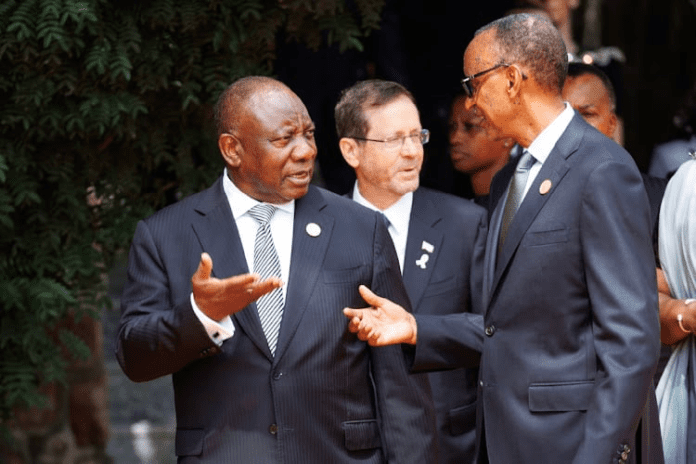Tensions between Rwanda and South Africa have escalated after Rwandan President Paul Kagame issued a strong warning to his South African counterpart, Cyril Ramaphosa, stating that Rwanda is ready for confrontation if necessary.
“If South Africa wants to contribute to peaceful solutions, that is well and good, but South Africa is in no position to take on the role of a peacemaker or mediator,” Kagame stated early Thursday morning.
“And if South Africa prefers confrontation, Rwanda will deal with the matter in that context any day,” he added in a post on X.
Kagame’s remarks came in response to Ramaphosa’s recent comments on the role of the Rwandan Defence Force (RDF) and the M23 rebel group in the ongoing conflict in the eastern Democratic Republic of Congo (DRC).
Ramaphosa had earlier accused RDF and M23 of intensifying the violence and attacking peacekeepers from the Southern African Development Community (SADC) Mission in the DRC (SAMIDRC).
“Following the recent intensification of fighting in the eastern Democratic Republic of the Congo, South Africa has lost 13 brave soldiers who were dedicated to their mission and committed to peace,” Ramaphosa stated.
“The fighting is the result of an escalation by the rebel group M23 and Rwanda Defence Force (RDF) militia engaging the Armed Forces of the DRC (FARDC) and attacking peacekeepers from the SADC Mission,” he added.
Responding on X, Kagame dismissed Ramaphosa’s remarks as misleading and accused South Africa of distorting facts about their conversations.
“I held two conversations this week with President Ramaphosa on the situation in eastern DRC, including earlier today. What has been said about these conversations in the media by South African officials and President Ramaphosa himself contains a lot of distortion, deliberate attacks, and even lies,” Kagame wrote.
He further asserted that Rwanda’s military is a national defense force, not a militia, rejecting South Africa’s characterization of its involvement in the DRC. Kagame also insisted that SAMIDRC is a combat force, not a peacekeeping mission, arguing that it was deployed as an ally of Kinshasa rather than a neutral force.
The public exchange between the two leaders has heightened fears of a direct confrontation between SADC and Rwanda. With South Africa reinforcing its troops in the DRC and Rwanda openly challenging its role, concerns over regional stability are growing.
Ramaphosa, in his national address, reaffirmed South Africa’s commitment to its military presence in the DRC, dismissing Kagame’s accusations and insisting that SAMIDRC was deployed to restore stability, not escalate conflict.
“South Africa’s military presence in the eastern DRC is not a declaration of war against any country or state,” he emphasized, adding that the mission aligns with SADC and United Nations efforts to bring peace.
He also called on all foreign forces, including Rwanda, to withdraw from Congolese territory in line with a recent United Nations Security Council resolution.
Kagame, on the other hand, blamed the failure of peace talks on the deployment of SAMIDRC, which replaced the East African Community (EAC) force that had been fostering dialogue.
He also claimed that Ramaphosa had privately admitted to him that FARDC, not M23, was responsible for the deaths of South African soldiers. Kagame further alleged that, contrary to Ramaphosa’s public stance, South Africa had requested logistical support from Rwanda, including electricity, food, and water for its troops in the DRC.
However, Ramaphosa maintained that the territorial integrity of the DRC must be respected in accordance with the UN Charter, emphasizing the need for peace.
Observers warn that the growing standoff between SADC and Rwanda could push the region closer to a military confrontation, which would have severe implications for stability across Central and Southern Africa.







